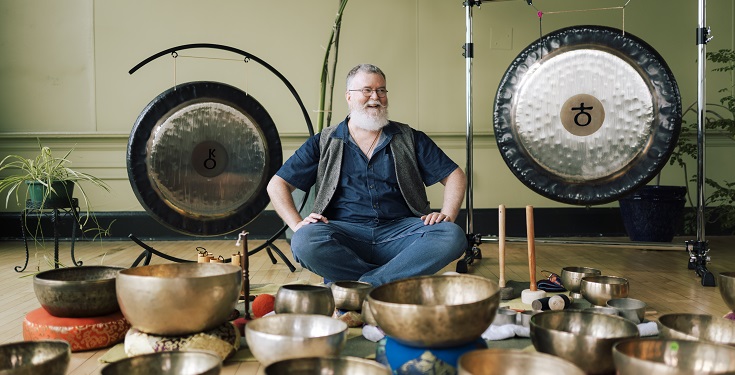A Sound Bath is a transformative experience and Ken Glowacki, DACM, LAc, Associate Professor in NUNM’s College of Classical Chinese Medicine, has been allowing it to evolve and vibrate into his practice over the years. And the process continues!
A Sound Bath is a therapeutic mind-body practice in which the patient or participant reclines in a comfortable position, often using yoga props to align the body as they “bathe” in the sounds produced by instruments.
How is Sound Resonance Therapy practiced?
The practitioner utilizes a wooden mallet to produce sound from hammered metal bowls called singing bowls, by striking or inviting the bowl and by rubbing around the outside rim of the bowls. Bowls produce vibrations at different frequencies depending on the size of the bowl.
Gongs, chimes, and cymbals may also be used to produce soothing vibrational sounds that gently fade out. Each singing bowl is unique with complex harmonies.
The practitioner may play the bowls and other instruments in a stationary position, by walking around with the instrument, or by placing the bowl on an individual’s body.
Resonance between two objects causes the second object to vibrate along with the first. When producing sound from a singing bowl, the vibration of the bowl will cause the room to become resonant, as well. Sound and movement become the focus and the solid and material fade into the background. Everyone participates. The practitioner only facilitates.

What is the background of Sound Resonance Therapy?
Dr. Mitchell Gaynor, an oncologist, found that sound therapy greatly enhanced his patients’ recovery. He recounts about his awakening to sound therapy in his book, The Healing Power of Sound, 1999.
“I had previously come to understand illness as a manifestation of disharmony within the body, an imbalance in the cells or in a given organ, such as the heart or lungs. Thus, the bowls, with their distinctive resonant tones, not only permitted me access to the ‘cosmic symphony,’ but also a means by which harmony could be restored within the body on the physiological as well as the psychospiritual level.”
Masuro Emoto demonstrated through his frozen-water crystal photography that music, words and sound could have an effect on the shape of frozen water crystals. Dr. Emoto introduced this concept in The Message from Water in 1999 and has shared his research and photography through several publications since.
A singing bowl will activate the water within a person’s body as it resonates. This resonance helps to settle different body systems, by bringing breath, qi 氣, entraining with the heart and balancing the autonomic nervous system.
Although the origin of the singing bowl is somewhat unknown, it is thought that they were once used to perform shamanistic rituals.
The deep meditative, focused state created in listeners through a Sound Bath, or Sound Resonance Therapy, lends itself to this application.
What are the therapeutic benefits of Sound Resonance Therapy?
The meditative experience of Sound Resonance Therapy invites the body into a relaxed, parasympathetic state, also known as the “rest-and-digest” state.
Individuals often feel profound changes such as their pulses balancing out, diminished stress, increased clarity and relaxation and a higher connection with their body. The sound seeks out blockages in our bodies and prompts the body to release into the new frequency.
Varying the frequency of the sounds produced can alter brain wave states resulting in participants experiencing a high functioning state, increased creativity, and improved sleep.
Sound therapy reaches the deepest levels of our being, our source, source qi, yuan 元氣. When we use sound therapy with acupuncture, it adds another level where we reach what we call the Extraordinary Vessels, qi jing ba mai 奇經八脈.
NUNM’s “Sound Resonance Therapy for Chinese Medicine”, an elective course in our College of Classical Chinese Medicine, introduces a variety of sound resonance therapies that are useful adjuncts to the practice of Chinese medicine. Students discuss and practice a variety of tuning fork applications, singing bowls and gongs, drumming, as well as vocal toning. Watch – and listen in – below, as Professor Ken Glowacki shares a powerful Singing Bowls Sound Bath demonstration with NUNM students.